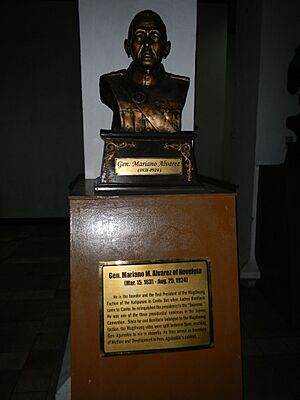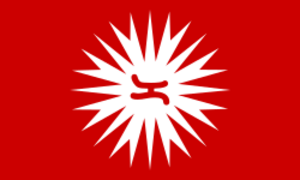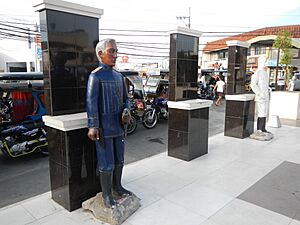Mariano Álvarez facts for kids
Quick facts for kids
Mariano Álvarez
|
|
|---|---|

Bust and commemorative plaque of Álvarez
|
|
| Municipal President of Noveleta | |
| In office 1901–1902 |
|
| Personal details | |
| Born | March 15, 1818 Tierra Alta, Cavite, Captaincy General of the Philippines |
| Died | August 25, 1924 (aged 106) San Roque, Cavite, Philippine Islands |
| Occupation | Teacher, General |
| Known for | General of the Philippine Revolution |
Mariano Malia Álvarez (March 15, 1818 – August 25, 1924) was an important Filipino hero. He was a brave leader in the fight for his country's freedom. He also served as a statesman, meaning he helped govern the country.
Contents
Early Life and Education
Mariano Álvarez was born in Tierra Alta, Cavite. His parents were Severino Álvarez and María Malia. He went to San José College in Manila. There, he studied hard and became a teacher. After finishing his studies, he returned to Cavite. He worked as a schoolteacher in the towns of Naic and Maragondon.
Challenges and Leadership
In 1871, Mariano Álvarez faced trouble. He was put in jail and treated badly by the Spanish rulers. This happened after a disagreement with a Spanish soldier. The next year, he was wrongly accused of being part of the Cavite Mutiny. This was a rebellion against the Spanish. He was taken to Manila and held in prison.
After he was released, he went back to Noveleta. In 1881, he was elected as a local leader. This position was called gobernadorcillo. Later, in 1893, he was re-elected. The title of his role changed to capitan municipal. He held this important position until 1896. That was when the Philippine Revolution began.
Leading the Revolution
Mariano Álvarez and his son, Santiago, were active members of the Katipunan. This was a secret group fighting for freedom from Spain. Andrés Bonifacio started this group in 1892. Mariano Álvarez was also the uncle of Bonifacio's wife, Gregoria de Jesús.
Katipunan Factions
In early 1896, Mariano Álvarez became the president of the Magdiwang. This was one of two main Katipunan groups in Cavite. The other group was called Magdalo. These two groups grew into separate factions. They even had their own local governments.
Álvarez helped many people join the Katipunan in Cavite. When the revolution started in August 1896, Bonifacio planned for him to lead all the fighters in Cavite. It is not clear if this order was officially sent out.
Battles and Victories
Mariano Álvarez led Filipino forces in many battles. They fought against the Spanish army in Cavite. He held the rank of general. His hard work helped free most towns in Cavite from Spanish control. This happened within weeks of the revolt starting. He was known as the person who started the revolution in Cavite.
Disagreements Among Leaders
There were some disagreements between the Magdiwang and Magdalo groups. They argued about who should lead and where their power ended. As the head of the Magdiwang, Álvarez invited Bonifacio to help settle these issues. Bonifacio was the Presidente Supremo (Supreme President) of the Katipunan. Some thought Bonifacio favored the Magdiwang group because Mariano Álvarez was his relative.
Some leaders, like Emilio Aguinaldo, later claimed that Bonifacio became the head of the Magdiwang. They said he was given the title Hari ng Bayan ("King of the People"). They also claimed Álvarez was his second-in-command. However, no official papers have been found to prove these claims. It is thought that these claims might have come from a misunderstanding. Bonifacio had a title that sounded similar. Santiago Álvarez, Mariano's son, wrote in his own memoirs. He clearly stated that the Magdiwang government and Bonifacio's Supreme Council were separate.
The disagreement between the Magdiwang and Magdalo groups grew. It soon became about who should lead the entire revolution. The Magdalo group wanted to get rid of the Katipunan. They wanted to create a new revolutionary government. Bonifacio and the Magdiwang group believed the Katipunan was already their government. Bonifacio eventually lost this power struggle to Aguinaldo. Mariano Álvarez was very sad about Bonifacio's death. Like Emilio Jacinto, he chose not to join Aguinaldo's forces.
Family Life
In May 1863, Mariano Álvarez married Nicolasa Virata y del Rosario. They had three children. One of their children was Santiago. Santiago also became a revolutionary general. He was born on July 25, 1872, in Imus.
Later Years
After the Spanish–American War and the Philippine–American War, the United States of America took control of the Philippines. Mariano Álvarez joined a political party that wanted independence. It was called the Partido Nacionalista (1901–1907). He was one of the people who signed the party's rules. He won the election to become the municipal president of Noveleta. He served in this role from 1901 to 1902.
In 1902, Álvarez joined the Philippine Independent Church. This church was started by Isabelo de los Reyes and Gregorio Aglipay. After his term as municipal president, he retired to his farm. Mariano Álvarez passed away on August 25, 1924. He was 106 years old. He died from a long-term illness called chronic rheumatism.
The municipality of Gen. Mariano Alvarez, Cavite was created in 1981. It was named in his honor.



